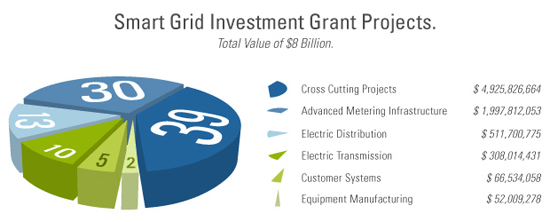The Smart Grid Investment Grant (SGIG) program aimed to accelerate the modernization of the nation’s electric transmission and distribution systems. The program selected projects—electricity providers across the nation with plans to upgrade their systems—through a merit-based, competitive solicitation (see the SGIG Funding Opportunity Announcement for details). As a result, a total of 99 projects received federal financial assistance for up to 50% of eligible project costs. Through these projects, the SGIG program promoted investments in smart grid technologies, tools, and techniques that increase flexibility, functionality, interoperability, cybersecurity, situational awareness, and operational efficiency.
The program was authorized by the Energy Independence and Security Act (EISA) of 2007, Section 1306, which called for federal matching funding for smart grid investment costs. The Recovery Act built on EISA to deliver $4.5 billion to jump-start grid upgrades, about $3.4 billion of which funded the 99 SGIG projects. When industry expenditures are included, the SGIG program represents an investment of about $8 billion in our nation’s electricity delivery systems.

The selection process ensured that SGIG projects covered a range of new technologies. Project scope generally fell into five categories (described below), with several electricity providers deploying equipment and/or software applications that covered two or more areas; for example, some utilities implemented advanced metering infrastructure (AMI), electric distribution systems, and customer systems. These projects were categorized as "integrated" or "cross-cutting."
Customer Systems
Customer systems enable smart grid functions in buildings, facilities, and appliances and equipment—i.e., on the customer side of the meter. These projects primarily involved adding smart grid functions to equipment and/or implementing customer-facing software applications. This category includes "smart" appliances and equipment, home area networks, building or facility energy management systems, distributed energy systems, demand response and load control equipment, energy storage devices, plug-in electric vehicles, and microgrids.
Advanced Metering Infrastructure
A majority of projects implemented advanced metering infrastructure (AMI), a system of smart meters, two-way communications networks, and data management systems. Together, these technologies enable metering and other information exchange between utilities and their customers. This two-way information exchange enables a range of new customer service applications, such as time-based rate programs, demand response programs, and web portals with near-real-time customer energy usage information.
A subset of SGIG projects conducted statistically rigorous studies to evaluate customer behavior in response to these new applications and other customer systems, such as in-home displays and programmable communicating thermostats. These studies employed randomized and controlled experimental designs with treatment and control groups. Through these project efforts, the SGIG program has advanced the electric power industry’s understanding of consumer behavior.
Learn more about the SGIG Consumer Behavior Studies
Electric Distribution Systems
Projects in this topic area added smart grid functions to local electric distribution systems in retail electricity markets. Projects primarily involved adding smart grid functions to devices, equipment, and/or software applications including substations, transformer banks, feeder lines, pole-top transformers, and customer interconnection and communications systems. Distribution system projects deployed distribution automation systems; supervisory control and data acquisition (SCADA) systems; distribution monitoring, control, and optimization systems; load control systems for lowering peak demand; and electric distribution applications of distributed generation and energy storage equipment.
Electric Transmission Systems
Several projects added smart grid functions to the electric transmission systems in the bulk power markets that typically involve power delivery over long distances, including multi-state regions. Projects primarily involved adding smart grid functions to devices, equipment, and/or software applications such as phasor measurement units, phasor data concentrators, and visualization tools that use phasor or other data; other types of remote sensing, monitoring, data acquisition and retrieval equipment; planning and control room applications; advanced communications and interconnection systems; and retrofit of electric transmission systems with smart grid functions and capabilities.
Equipment Manufacturing
Several projects designed, produced or purchased smart grid systems, equipment, devices, software, or communications and control systems for modifying existing electric system equipment; building, office, commercial, or industrial equipment; consumer products and appliances; or distributed generation, demand response, or energy storage devices to enable smart grid functions.
Learn more about the Smart Grid Investment Grant program:
Projects
The location, information, and data for each smart grid project are provided in this section.Click for Projects
Publications
These reports include analysis, impacts, lessons learned, best practices, analytical tools, and case studies that were supported by the Recovery Act Smart Grid Programs.Click for Publications

